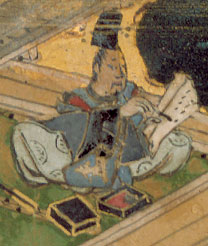–The first thing that is taught is how to fall down without being hurt, that alone is worth the price of admission and ought to be taught in all our gyms.
–The great educator, John Dewey, on observing the training methods of Jigoro Kano;
From his, Letters from China and Japan
–Fukuda’s training method consisted mostly of the student taking fall after fall for the teacher or senior student until he began to understand the mechanics of the technique.
–of Fukuda Hachinosuke, Jigoro Kano’s instructor of Jiu Jitsu
From Wikipedia
Long before the practice of Brazilian Jiu Jitsu stole my heart and placed me on solid ground, I was an Aikidoist. It was the soaring blue skirts that caught my eye and got me hooked–the elegance of hakama fluttering and snapping through the air like indigo stunt kites spinning in the wind. The ukemi–the sophisticated art of falling that followed a well executed throw–appealed to some inner acrobat that I had known since childhood, and even if I doubted I would ever have the ability to throw people with effortless arm circles, I knew I could learn to take a fall.
My early interest in ukemi served me well. When, after five years of refining my ability to hit the mat, I began studying with the esteemed Shihan, Hiroshi Ikeda, I became one of his favorite throwing dummies. Ikeda Sensei, like Jigoro Kano, and Fukuda Hachinosuke before him, believed that in order to learn to throw hard, one first had to learn to fall hard. A student with good ukemi provided the advanced student or teacher the opportunity to work with powerful attacks. In turn, the confidence given the beginner by his well practiced ukemi opened him up to experience the mechanics of high level throws. In the state of relaxation and sensory awareness brought on by his trained survival instinct, the student was believed to be able to “steal” his teacher’s technique.
This makes perfect sense. When our minds are consumed with fear, we can focus on little else. Those of us who remember ourselves as beginners of Jiu Jitsu may be able to remember a time when everywhere our seniors placed their limbs felt like a threat. We pushed it all away, not sure how to engage or what would happen if we did. If we could squeeze like our lives depended on it, and restrict all movement for even thirty seconds, we were happy. I can remember when my teachers would spin under me, maybe offering a north-south position, or side control, and I would spring away like a cat. I didn’t know what was good and what was bad, so I assumed that everywhere my seniors moved was dangerous. Over time I relaxed. I worked through armbars, chokes, fought my way from the bottom back to my guard. Maybe I didn’t win a lot, but I became confident enough to engage. I wasn’t paralyzed anymore, and then I really began to learn.
There is a philosophy here that pervades the martial arts and dates back at least as far as the Samurai of Japan. The process of technical refinement involves at it’s core what behavioral psychologists call systematic desensitization. Because the areas where we have technical blind spots induce anxiety and disrupt our fluidity, whenever we get close to them we find ourselves straining, panicking, and resisting against movement. If we can identify these areas and work through them in a relaxed way, when the stakes are low, we usually find they don’t disrupt our flow so much when we come up against them the next time. The Samurai were encouraged to elevate this practice to the psychological sphere. Rather than ignore or talk over frightening thoughts, their instruction was to examine them through meditation. “Meditation on an inevitable death” is prescribed as a daily practice in Hagakure–it was a logical extension of the practice of ukemi. The fear of death, like the fear of any fall, would stem from one’s unpreparedness to face it, and it would be equally paralyzing in the moment when action was required.
We might think a warrior, actual or metaphorical, should be mentally rehearsing for victory–should visualize success. To be fair, there was this element to a Samurai’s instruction. But this practice was reserved for the moments just before battle. The hard work completed, he would be harnessing a resolve that was strengthened through countless hours of physical and mental conditioning. Like the Judoka prepared to fall at all possible angles, his mind would be trained to remain fluid whatever chaos ensued. Through observation and empirical data the Samurai understood what we have now determined through science: fear skews our perceptions, and disturbs our relationship to space and time. A recent study indicates a direct (negative) correlation between our level of fear and our ability to accurately measure timing and distance and anticipate collision. To perform well we must be relaxed, and to be relaxed we must be physically and mentally prepared.
We who study the martial arts–whether we are training for self defense, for competition, or for self improvement–are familiar with the value of ukemi and, by extension, the practice of systematic desensitization. We routinely identify and defuse the “negative” possibilities of technical situations. Negative is in quotes because once we have uncovered and trained for a possibility, it loses its negative power and becomes an opportunity we know how to capture. We start to find advantages in positions that might have felt devastating on our first day, and technical situations we may have resisted tooth and nail before we had prepared through technical practice, we begin to flow through as though the movements were choreographed. (In a way, they have been.) The deeper our understanding of each situation, the more we are able to relax and greet it positively when it appears.
Why stop there? Martial arts practice teaches us a valuable lesson about our construct of negative and positive thinking–the things we most fear are those that we have not studied deeply, the thoughts and projected possibilities that seemed too daunting to consider. Should we push them down, repress or resist them–or is this a surefire way to trip ourselves up when the stakes are high? Our art teaches us a very effective way of transforming these negative thoughts and potentialities into opportunities for growth, but often we practice in one way and live in another. We get caught up in a thinking fad that is infinitely less developed than our art. We confuse purposeful ignorance or mental laziness with positivity. Consider how our meticulous and unflinching study has informed and deepened the experience of our art, and developed our appreciation for nuance and subtlety. We now see beauty in movements and situations that used to seem foreign, frightening, or perplexing, and we find creative solutions to problems that used to seem like certain defeat. Should we really be developing our mind with any less meticulousness than we give to our art? Or should we be striving to experience the rest of our lives with that same degree of depth and clarity?



Muleke
March 21, 2015 at 12:37pmI love these writings of yours. Please continue updating your blog